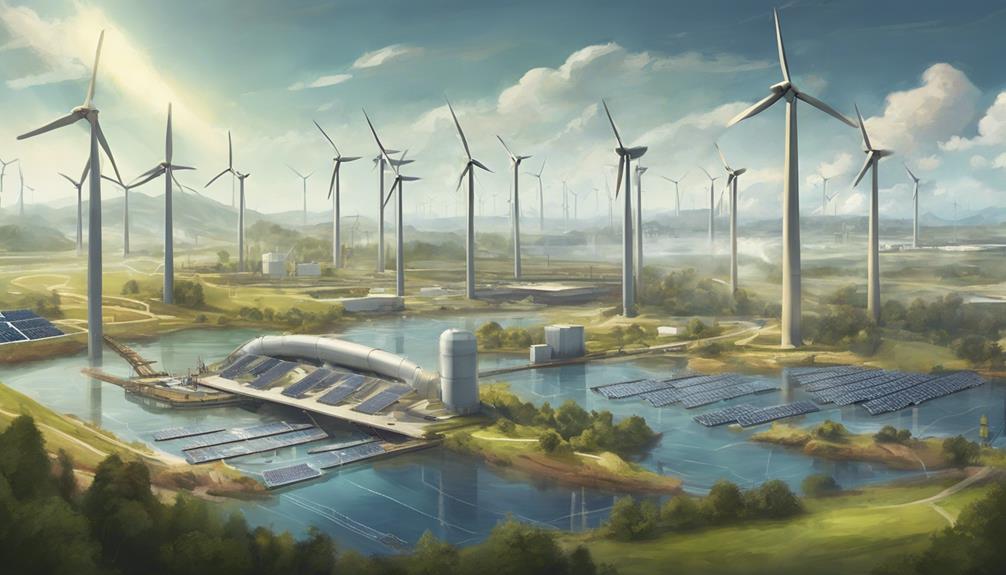Renewable energy sources hold promise in addressing the global energy demand and mitigating environmental concerns, yet the question of whether they can truly power the world remains complex. While advancements in technology and growing investments in renewables are encouraging, challenges persist in terms of scalability, reliability, and infrastructure. The discussion surrounding the transformative potential of renewable energy requires a nuanced examination of the interplay between innovation, policy, and practical implementation. In exploring the feasibility of a renewable-powered world, considerations must extend beyond theoretical possibilities to real-world applications and sustainable energy solutions that can meet the demands of a rapidly evolving global energy landscape.
Key Takeaways
- Renewable energy adoption is increasing globally, with potential to power the world sustainably.
- Technological innovations and advancements in solar and wind energy enhance efficiency.
- Transitioning to renewables decreases emissions, enhances energy security, and creates jobs.
- Policy challenges and economic implications need addressing for a successful renewable energy transition.
Global Energy Demand and Renewables
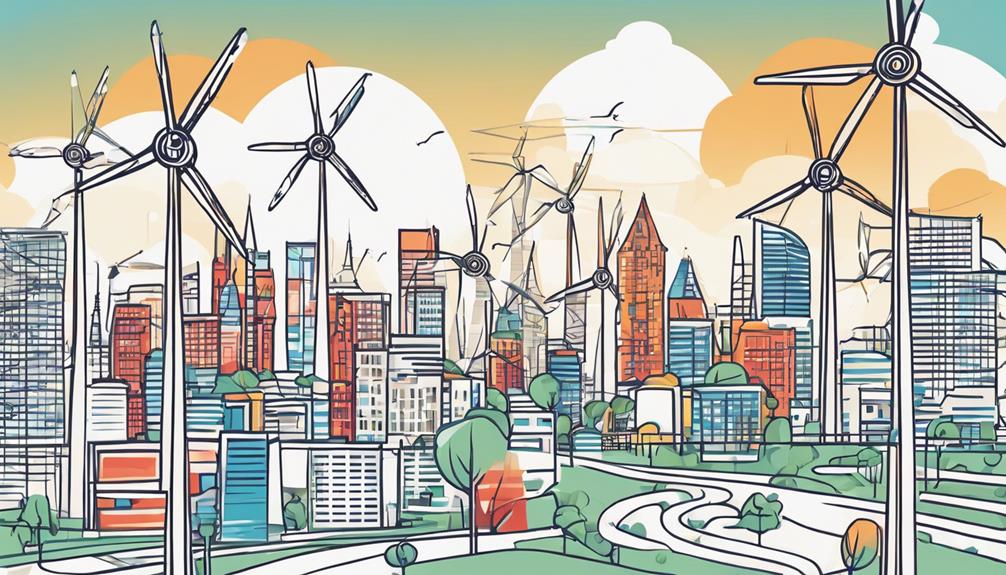
Renewable energy sources have become increasingly integral to meeting the global energy demand, with over 26% of electricity generation derived from renewables in 2020. The transition towards renewable energy is gaining momentum globally as countries like Denmark and Germany set ambitious targets for renewable energy production. Denmark aims to produce 70% of its energy from renewables by 2020, while Germany targets 80% by 2050. China stands out for its leadership in renewable energy investment and solar manufacturing, indicating a shift towards sustainable energy sources on a global scale. In the U.S., renewables contribute to approximately 13% of the energy mix, with significant growth seen in the solar market. Despite these advancements, renewable energy remains a small fraction of the overall energy production globally. However, the projected growth of solar power by over 20% in 2014 demonstrates the potential that renewable sources could provide in meeting the rising global energy demand.
Advantages of Renewable Energy Sources
The increasing utilization of renewable energy sources aligns with global efforts to address pressing environmental concerns and enhance energy sustainability. Renewable energy sources offer numerous advantages, contributing significantly to combating climate change, reducing air pollution, enhancing energy security, fostering economic growth, and supporting the global fight against climate change.
| Advantages | Description |
|---|---|
| Climate Change | Renewable energy sources can significantly reduce greenhouse gas emissions, combating climate change. |
| Air Pollution | Adoption of renewable energy sources can lead to decreased air pollution and improved air quality. |
| Energy Security | Renewable energy sources enhance energy security by diversifying the energy mix. |
| Economic Growth | The renewable energy sector creates jobs, supporting economic growth and stability. |
| Global Fight | Transitioning to renewable energy sources helps in the global fight against climate change. |
Challenges in Renewable Energy Transition
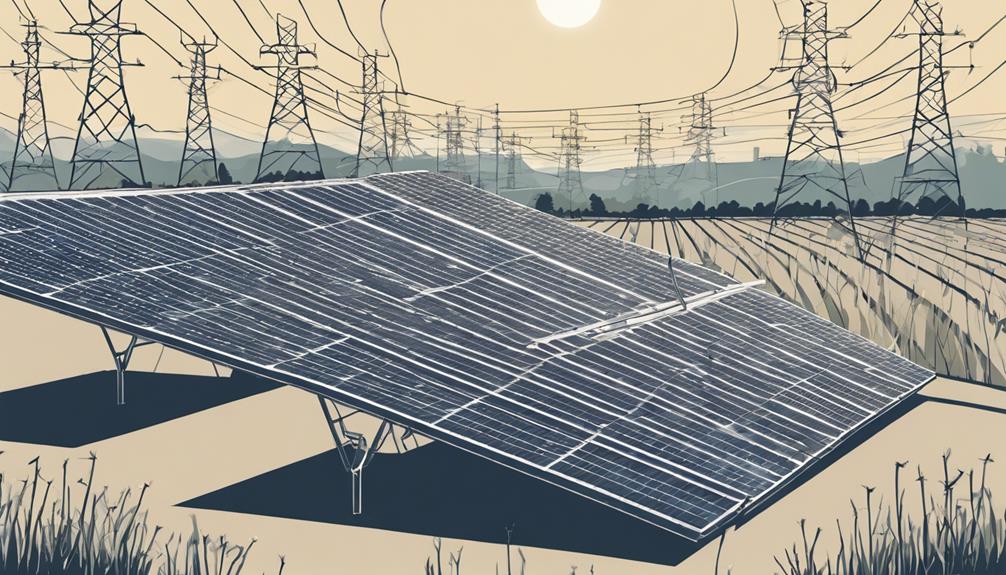
Amidst the global push towards sustainable energy solutions, the transition to renewable sources presents a myriad of challenges that require strategic and innovative approaches for successful implementation. Transition challenges include the need to quadruple the production of rare-earth metals like dysprosium and neodymium, essential for technologies such as wind turbines and electric vehicles. Moreover, the transition necessitates vast quantities of materials such as steel and cement for renewable energy infrastructure, with estimates indicating a requirement of nearly 2 billion metric tons of steel and 1.3 billion metric tons of cement by 2050, highlighting concerns regarding material availability. Ensuring responsible mining practices is crucial to avoid environmental harm and exploitation of communities. Emissions impacts from mining and processing materials for renewable energy could contribute significantly to carbon dioxide emissions, with steel, cement, and polysilicon production being major contributors. Efforts to reduce emissions from heavy industries like steel and cement are vital to offset the climate impact of establishing renewable energy infrastructure.
Technology Innovations Driving Renewable Energy
Recent technological advancements in solar panel efficiency, wind turbine design, and energy storage solutions are reshaping the renewable energy landscape. Innovations such as perovskite tandem solar cells and hybrid systems are pushing the boundaries of efficiency and performance, promising a more sustainable future. These breakthroughs highlight the critical role of technology in driving the transition towards cleaner and more efficient renewable energy sources.
Solar Panel Efficiency
Propelling the advancement of renewable energy technology, particularly in solar panel efficiency, innovative developments in perovskite tandem solar cells are poised to redefine the landscape of sustainable power generation. Perovskite tandem solar cells offer the potential to achieve record efficiencies for solar panels by combining traditional silicon with perovskites, significantly enhancing overall efficiency. The ongoing technological advancements in perovskite-silicon hybrid solar cells hold the promise of revolutionizing solar panel efficiency, with super-efficient solar cells utilizing perovskite technology on the horizon. These breakthroughs in solar cell technology are expected to be pivotal in driving advancements in renewable energy adoption, paving the way for more sustainable and efficient energy production on a global scale.
Wind Turbine Advancements
The evolution of wind turbine technology stands as a pivotal force in driving the progress of renewable energy infrastructure, with advancements in design and functionality revolutionizing the efficiency and effectiveness of wind power generation. Advanced designs have significantly increased efficiency, with some models achieving capacity factors exceeding 60%. Offshore wind turbines, especially larger models, are gaining popularity due to their ability to generate more electricity by harnessing stronger and more consistent winds. Innovations in blade design, incorporating materials like carbon fiber and aerodynamic shapes, have enhanced performance and durability. The integration of digital technologies, such as sensors and data analytics, has optimized wind turbine operations, leading to higher output and reduced maintenance costs. Additionally, the emergence of floating wind turbines shows promise in enabling deployment in deeper waters, expanding offshore wind energy generation potential.
Energy Storage Solutions
Energy storage solutions play a pivotal role in enabling the effective utilization of renewable energy sources by addressing the intermittency and variability inherent in solar and wind power generation. Various technologies contribute to efficient energy storage, including lithium-ion batteries for smaller-scale applications and pumped hydro storage for larger-scale needs. Grid-scale energy storage options like flow batteries and compressed air energy storage are under development to support renewable energy integration into existing grids. Thermal energy storage innovations, such as molten salt systems in concentrated solar power plants, allow for continuous electricity generation even after sunset. Advancements in smart grid technologies and demand response systems further enhance the adaptability and efficiency of energy storage solutions in managing the variability of renewable energy sources.
| Energy Storage Solutions | Technologies |
|---|---|
| Lithium-ion batteries | Small-scale applications |
| Pumped hydro storage | Large-scale energy storage |
| Grid-scale energy storage | Flow batteries, Compressed air |
| Thermal energy storage | Molten salt systems |
| Smart grid technologies | Demand response systems |
Economic Implications of Renewable Energy
Investments in renewable energy have the potential to significantly impact global economies by reducing costs associated with pollution and climate change. Transitioning to renewable energy sources presents various economic implications:
- Cost Savings: Renewable energy investments could save $4.2 trillion annually by 2030 by reducing pollution and climate impacts.
- Market Stability: The shift towards renewable energy can lead to market stability, reducing dependency on volatile fossil fuel prices.
- Enhanced Energy Security: Diversifying energy sources with renewables enhances energy security, reducing reliance on imported fuels.
- Job Creation and Inclusivity: The renewable energy sector creates three times more jobs than fossil fuels for every dollar invested. By 2030, the clean energy transition could generate 30 million new jobs, promoting inclusivity through a just transition.
These factors highlight the significant economic benefits associated with investing in renewable energy, emphasizing the need for countries to prioritize and support the transition towards sustainable energy sources.
Policy and Regulatory Hurdles
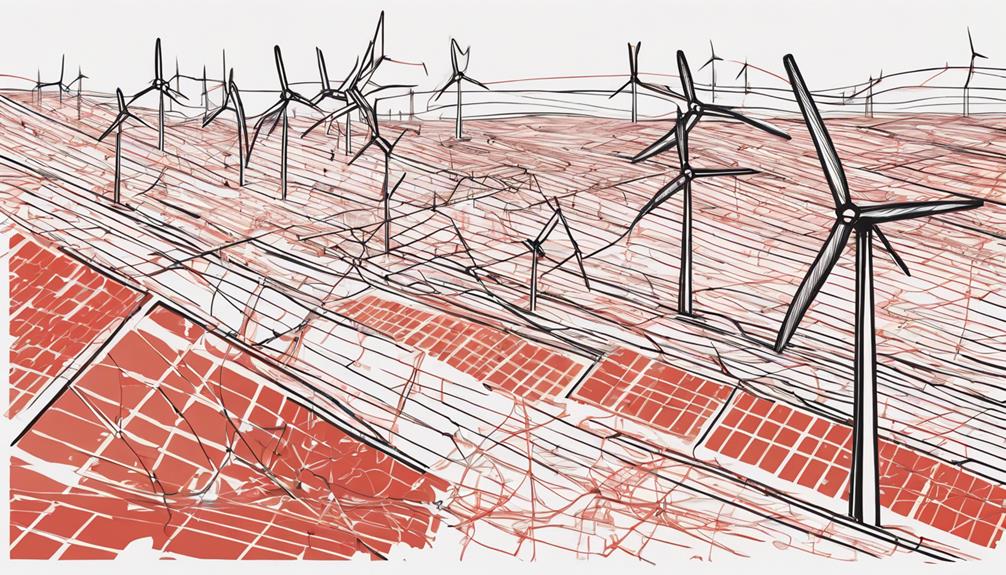
Policy and regulatory hurdles in the renewable energy sector present significant challenges that can impact its growth and development. Inconsistent support and lack of long-term policies may deter investments, while grid integration issues and regulatory barriers can impede the full utilization of renewable energy sources. Uncertainty in regulatory environments further complicates the landscape, potentially discouraging investors from engaging in sustainable energy projects.
Regulatory Challenges Ahead
Amidst the transition towards renewable energy sources, what key regulatory challenges pose significant obstacles to the seamless integration of clean technologies?
- Policy inconsistencies: Varying policies at local, national, and international levels can create confusion and hinder the development of renewable energy projects.
- Long-term planning: The lack of clear, consistent long-term strategies can deter investors from committing to renewable energy initiatives.
- Regulatory uncertainty: Unclear regulations and unpredictable changes in policies can increase risks for stakeholders in the renewable energy sector.
- Investment and project approvals: Complex permitting processes, coupled with regulatory barriers, can delay investment decisions and project implementation, slowing down the adoption of renewable energy technologies.
Policy Impacts on Renewables
Navigating the landscape of renewable energy development is intricately tied to the regulatory and policy challenges that can either propel or impede the growth of clean technologies. Policy impacts play a crucial role in shaping the investment and deployment of renewable energy sources worldwide. Inconsistent regulations and uncertain policies create barriers for investors, hindering the expansion of sustainable energy projects. Strong and stable renewable energy policies are essential for encouraging innovation and fostering industry growth. Effective policy frameworks can drive the transition towards a more sustainable and renewable energy-powered world.
| Policy Impacts on Renewables |
|---|
| Hindrance to Investment |
| Uncertainty in Deployment |
| Importance of Stable Policies |
Role of Energy Storage Solutions
Energy storage solutions play a pivotal role in optimizing the efficiency and reliability of renewable energy sources by storing surplus energy for peak demand periods. These solutions are essential for managing the intermittency of renewable sources like solar and wind power, ensuring a stable energy supply. Key energy storage technologies include:
- Lithium-ion batteries: Widely used for their reliability and scalability in storing energy generated from renewables.
- Pumped hydro storage: Cost-effective and accounting for over 95% of global energy storage capacity, this method involves pumping water to higher reservoirs during low-demand periods and releasing it to generate electricity during high-demand periods.
- Emerging technologies: Redox flow batteries, compressed air energy storage, and thermal energy storage systems are continually evolving to offer efficient energy storage solutions.
These storage solutions are vital for enabling the transition to a renewable energy-based future by overcoming the challenges of intermittency and ensuring a reliable power supply.
Path to Achieving Global Renewable Energy Goals
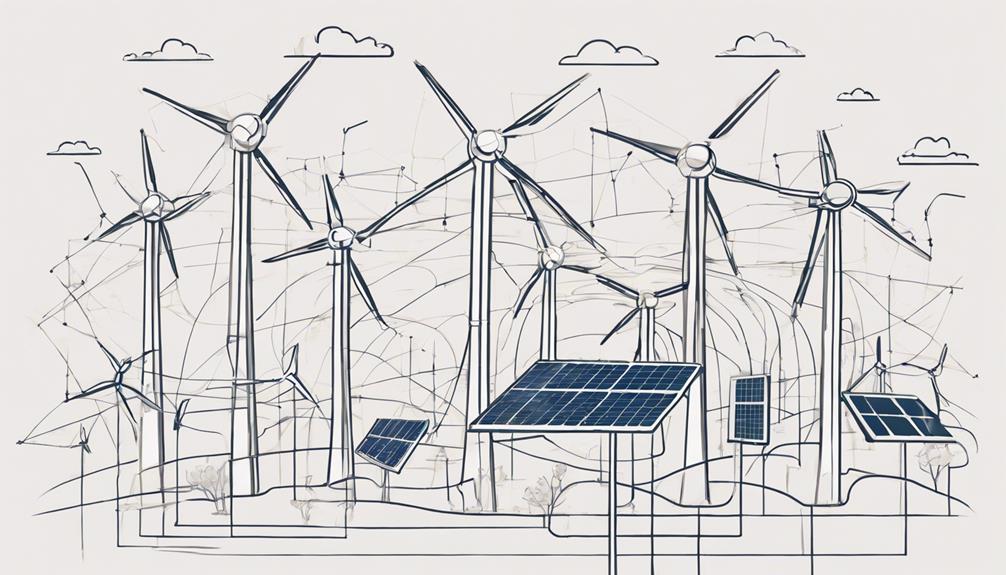
Renewable energy targets set by countries worldwide are driving a significant shift towards cleaner and more sustainable power sources. The global focus on achieving these goals is evident in Denmark's aim for 70% clean power by 2020 and Germany's target of 80% by 2050. China's leadership in renewable investment and solar manufacturing plays a crucial role in the growth of global renewable energy. In the U.S., the push for 13% of energy from renewables is exemplified by the 41% growth in the solar market in 2013. The increasing momentum in renewable energy adoption is highlighted by the at least 47 gigawatts of wind energy installations worldwide in 2014. Despite challenges, projections show that renewable energy could supply 80% of U.S. electricity by 2050, indicating a substantial transition towards sustainable energy sources. The integration of solar and wind technologies is pivotal in achieving these global renewable energy goals and fostering a cleaner and more sustainable energy future.
Frequently Asked Questions
Is It Possible to Power the World With Renewable Energy?
It is feasible to power the world with renewable energy sources. Global impact, energy efficiency, technological advancements, economic benefits, environmental sustainability, and energy transition are key factors. The transition to renewables can significantly reduce greenhouse gas emissions, enhance energy security, and create jobs. As renewable technologies advance, their potential to meet global energy demands grows. Embracing renewables offers a sustainable solution to energy needs, fostering a cleaner and more secure energy future.
Can 100% Renewable Energy Power the World?
Achieving 100% renewable energy to power the world presents a complex challenge. Considerations such as global impact, energy transition speed, technological advancements, economic feasibility, environmental benefits, and energy storage capacity must be carefully evaluated. While renewable sources offer promise, addressing these factors in a comprehensive manner is essential for a successful transition. Balancing these aspects is crucial in determining the viability of relying solely on renewable energy for global power needs.
Is Renewable Energy Good for the World?
Renewable energy offers a multitude of benefits for the world. Environmental benefits include reduced greenhouse gas emissions and improved air quality. Economically, it fosters growth by creating new jobs and industries. Enhancing energy security, renewable sources mitigate reliance on fossil fuels. Technological advancements in this sector drive innovation. Moreover, renewable energy aligns with global efforts to combat climate change, making it a crucial tool for achieving sustainable development goals.
Can Renewable Energy Change the World?
Renewable energy has the potential to revolutionize the world in terms of global impact, technological advancements, economic benefits, environmental sustainability, energy transition, and policy implications. By shifting towards renewable sources, societies can reduce carbon emissions, mitigate climate change, and enhance energy security. This transition requires significant investments in infrastructure and innovative technologies to maximize the benefits of renewable energy on a global scale.
Conclusion
In conclusion, the potential of renewable energy sources to power the world is promising, with advancements in technology and increasing global investments driving the transition towards a cleaner, greener future. While challenges such as intermittency and regulatory obstacles exist, innovations in energy storage solutions and policy changes can help overcome these hurdles. By continuing to prioritize renewable energy adoption and working towards global goals, we can create a more sustainable and resilient energy system for the future.
